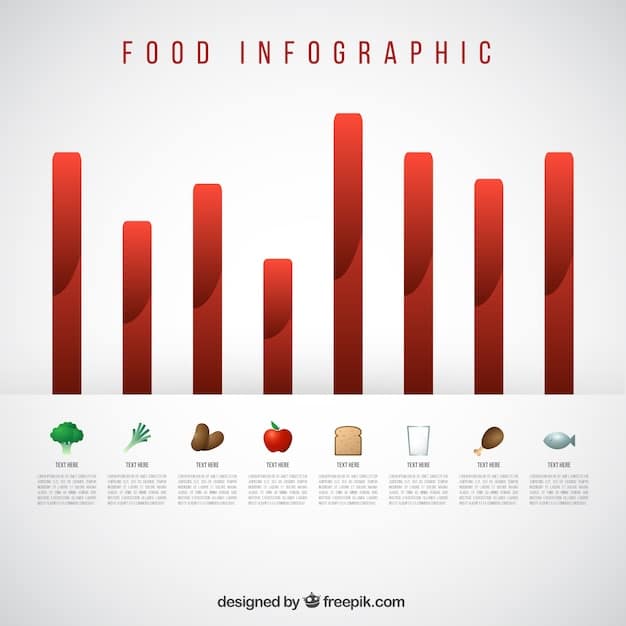Fact Check: Unpacking the Claims of a 12% Food Price Increase in the US

Reports of a nationwide 12% increase in food prices are circulating, but a thorough fact check reveals a more nuanced picture, considering various factors and data sources to assess the accuracy of this claim.
Claims of a fact check: are reports of a nationwide increase in food prices by 12% accurate? have surfaced, leaving consumers concerned about their grocery bills. Is this figure a true reflection of what’s happening at the checkout, or is it an oversimplification of a more complex economic reality?
Understanding the Recent Food Price Trends
To accurately assess claims of a 12% nationwide increase in food prices, it’s essential to understand the recent trends shaping the food market. Multiple factors, including supply chain disruptions and inflation, play a significant role in the fluctuations we’re seeing.
Examining key economic indicators and reports from reputable sources such as the Bureau of Labor Statistics (BLS) and the USDA provides valuable insights into the underlying dynamics influencing food costs.
Key Economic Indicators
Monitoring economic indicators can help gauge the overall health and stability of the food market by highlighting potential risks and opportunities.
- Consumer Price Index (CPI): Tracks the average change over time in the prices paid by urban consumers for a basket of consumer goods and services.
- Producer Price Index (PPI): Measures the average change over time in the selling prices received by domestic producers for their output.
- Food Price Index (FPI): An indicator used by global institutions to track international food commodity prices.
These indicators can offer different perspectives on food price changes, from the costs incurred by producers to the prices paid by consumers.
In summary, understanding food price trends requires a comprehensive approach that incorporates insights from trustworthy economic indicators and expert analyses.
Analyzing the Data: Is There a 12% Increase?
The claim of a 12% nationwide increase in food prices requires a rigorous analysis of the available data from reliable sources. By examining data from the Bureau of Labor Statistics (BLS) and comparing it with other reports, we can either validate or debunk this assertion.
Comparing the rumored figures with real-time data offerings can provide clarity on actual current food expenses.
Bureau of Labor Statistics (BLS) Data
The BLS is a primary source for tracking price changes in the U.S. economy. Its data on food prices is comprehensive and widely used by economists and policymakers.
Comparing reports between different time frames illustrates both short-term and long-term inflationary trends.
- Monthly Consumer Price Index (CPI) reports: These reports provide monthly updates on consumer prices, including food.
- Annual CPI reports: These reports summarize price changes over the course of a year.
By examining these reports, one can gain a clear understanding of how food prices have evolved over time.
Ultimately, a rigorous analysis of BLS data helps clarify whether the 12% figure is accurate.

Scrutinizing the Factors Influencing Food Costs
A thorough examination of the various elements affecting food costs helps decipher complexities driving the market.
Understanding details such as production, distribution, and supply and demand aspects is crucial in understanding food price dynamics.
Impacts of Supply Chain Disruptions
The pandemic dramatically disrupted the global supply chain, affecting the production and distribution of numerous goods, including food.
- Labor shortages: Reduced workforce availability in farms, processing plants, and transportation sectors.
- Transportation bottlenecks: Delays and increased costs in shipping and logistics.
- Input costs: Rising prices for fertilizers, packaging, and other agricultural essentials.
These disruptions have led to higher costs that are often passed on to consumers, affecting retail food prices.
In light of these factors, supply chain issues can significantly influence food costs.
Comparing Food Price Inflation to Overall Inflation
When looking at food price inflation, it’s important to put it in the context of overall inflation in the economy.
Understanding how food inflation aligns with broader economic trends can provide practical information on whether it’s disproportionately impacting consumers.
Current Economic Situation
Inflation refers to the rate at which the general level of prices for goods and services is rising, and subsequently, purchasing power is falling.
Food inflation stands apart from the overall rate of inflation in terms of its causes and effects on households.
- Energy Prices: Rising costs of gasoline and electricity impact transport and production expenses.
- Global Events: International affairs can significantly affect trade agreements and supplies.
Evaluating food price increases in comparison to broader economic occurrences can bring depth to understanding cost and market variables.
Ultimately, context is essential when evaluating food price inflation against overall economic conditions.

Expert Opinions on the Accuracy of Food Price Claims
Expert opinions play a critical role in evaluating claims about food price increases, providing insights based on economic analysis and industry knowledge.
Consulting economists, market analysts, and agriculture experts can offer varied perspectives on the truthfulness of the rumored 12% increase.
Insights from Economists
Economists study market trends and economic data to offer informed perspectives on changes in food prices.
Their research helps uncover underlying issues, such as policy effects and consumer expenditure behaviour.
- Data Interpretation: Experts can interpret complicated data sets and derive major conclusions.
- Predictive Analysis: Using complex modelling to forecast future trends.
By analyzing data and market dynamics, economic experts contribute toward precise evaluations of statements about food prices.
Gathering these diverse perspectives is crucial for a clear understanding of the dynamics influencing food costs.
| Key Point | Brief Description |
|---|---|
| 📈 Inflation | Rising prices for goods and services impact buying power. |
| 🚚 Supply Chains | Breakdowns result in greater expenses and shortages. |
| 📊 BLS Data | Principal resource for monitoring price shifts in the United States. |
| 💰 Consumer Impact | Food expenditures are affected by market dynamics. |
Frequently Asked Questions (FAQ)
Several factors contribute to food price increases, including supply chain disruptions, rising energy costs, labor shortages, and overall inflation. These elements collectively impact production and distribution costs, driving up prices.
Food price inflation in the U.S. is primarily measured using the Consumer Price Index (CPI) published by the Bureau of Labor Statistics (BLS). The CPI tracks changes in the prices of a basket of goods and services, including food items.
No, different food categories can experience varying rates of inflation. Factors such as specific supply chain issues, seasonal changes, and demand fluctuations can impact the prices of certain categories more than others.
Global events, such as trade disputes, geopolitical tensions, and climate-related disasters, can significantly impact food prices in the U.S. These events can disrupt international supply chains, affect commodity prices, and influence agricultural production.
Consumers can mitigate the impact of rising food prices by planning meals, buying in bulk when possible, utilizing coupons and discounts, shopping at farmers’ markets, and reducing food waste. These strategies can help manage household food budgets.
Conclusion
In summary, while reports of a 12% nationwide increase in food prices have circulated, a thorough fact check reveals a more intricate reality. The actual changes can vary significantly across different regions and food categories, influenced by a combination of supply chain dynamics, economic factors, and global events. It is crucial to consult verified data and insights from economic experts to comprehensively understand and address the impact of food costs on consumers.





